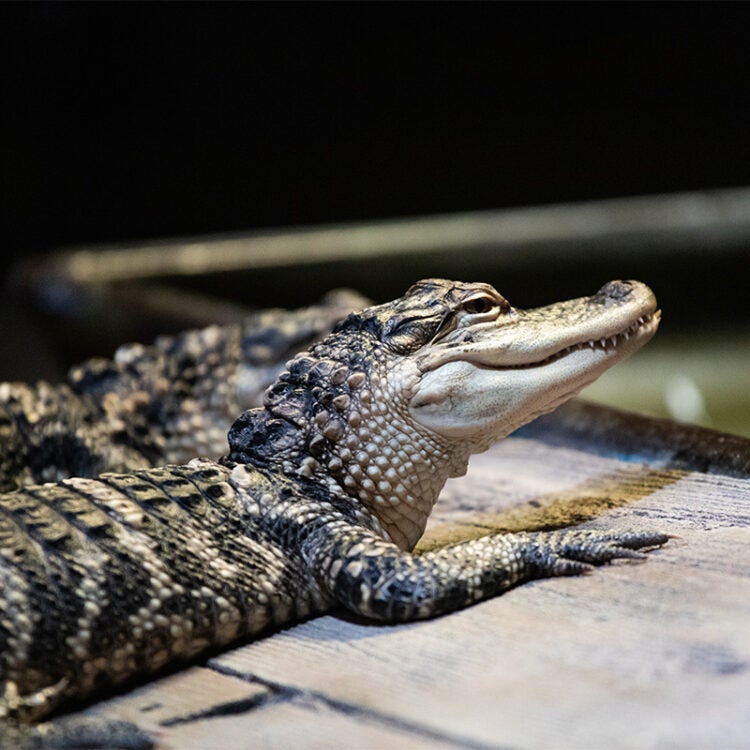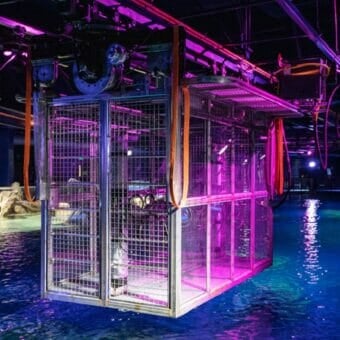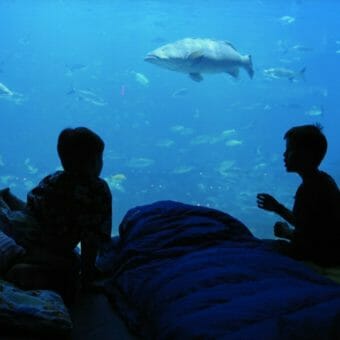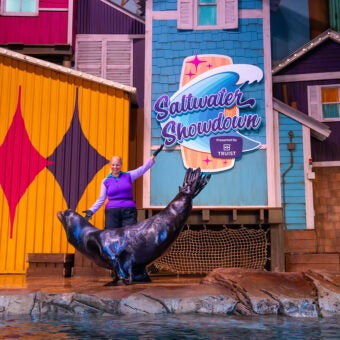-
Size
10-15 feet (3-4.5 m) in length -
Diet
Nearly any aquatic or terrestrial prey that comes within range -
Range
Southeastern United States -
Habitat
Freshwater swamps and marshes, as well as in rivers and lakes
Physical Characteristics
- Adult male American alligators typically reach 13-15 feet (4.0-4.5 m) in length. Females reach lengths of about 10 feet (3 m). The tail is about one-half the body length.
- Characteristically broad snout. The upper jaw is wider than the lower jaw and completely overlaps it so that the edge of the upper jaw overlaps teeth in the lower jaw.
- Bottom teeth are almost completely hidden when the mouth is closed. This is in contrast to crocodiles, in which the lower teeth are visible outside of the upper jaw.
- Juveniles are darker in color with bright yellow cross-bands. Aging brings the gradual loss of the banding and the alligator will turn olive brown and black, with some areas around the jaws and neck a creamy white. The ventral surface of the body is pale.
- Adults usually have 74-80 teeth. New teeth grow to replace lost or damaged ones.
- Small, sensory pits dotted around the upper and lower jaws can detect small pressure changes in water and assist in locating and capturing prey.
Animal Fun Fact
The American alligator has sensory pits that detect changes in water to find prey.
Diet / Feeding
- Adults are opportunistic feeders and their diet consists of nearly any aquatic or terrestrial prey that comes within range. This includes fish, turtles, small mammals, birds and reptiles, and even smaller alligators.
- Juvenile diets consist of small invertebrates, particularly insects, as well as small fish and frogs.
- Foraging will cease when water temperature drops below about 68 degrees F (20 degrees C).
Range / Habitat
- Occurs in the Southeastern U.S. in the following states: Alabama, Arkansas, North and South Carolina, Florida, Georgia, Louisiana, Mississippi, Oklahoma and Texas.
- Found primarily in freshwater swamps and marshes, as well as in rivers, lakes and smaller bodies of water. Individuals also can be encountered in ditches, drainage canals, subdivision waterways, golf course ponds and roadways.
- This species can tolerate low levels of salinity for short periods and is occasionally found in brackish water around mangrove swamps.
Reproduction & Growth
- Elaborate courtship ritual involving low-frequency bellowing, head-slapping on the surface of the water, complex body posturing, touching and release of musk-like scents.
- Fertilization is internal.
- Females build a mound nest of vegetation and mud that is elevated above any high water mark. They dig a conical nest on top, deposit 20-50 eggs in it, and then covers them with vegetation. Females remain nearby during the 65-day incubation period, defending the nest from predators.
- The chirping of the new hatchlings brings the mother back to the nest and she carries them, eight to ten at a time, in her mouth down to the water.
- Hatchlings form pods and remain close to their mother for about one year or more. She aggressively protects them from all predators, particularly large dominant male alligators.
- As is common to many reptile species, the gender of hatchling alligators is determined by the temperature during incubation. Males are produced in warmer parts of the nest and females in cooler areas.
Conservation Status
- “Least Concern” on the IUCN Red List.
- Included in Appendix II of CITES to assist in the control of trade in other crocodilian species whose skins are similar in appearance.
- American alligator populations in the U.S. were severely depleted in most areas during the first half of the twentieth century due to over-exploitation. Legislative protection was afforded to it in the 1960s and conservation efforts and monitoring were initiated. The recovery of this species has been extremely successful, current wild populations are estimated to be in the millions.
- Recovery of the species from near extinction is partly due to programs of human rearing and reintroduction of juveniles into habitats alligators formerly occupied (e.g., in Arkansas, Mississippi, Louisiana). Proper management practices, including controlled hunting, are ongoing to ensure the sustainability of populations.
Additional Information
- Considered a “keystone species” in some habitats, such as the Florida Everglades, because of its vital role in the ecosystem.
- In the Everglades, alligators modify the habitat by creating “alligator holes” which they excavate from mud and peat in the substrate using both the snout and tail. These water-filled holes provide refuge for other animals such as fish during dry periods and also provide foraging sites for wading birds, turtles and snakes. In addition, alligator nests provide elevated areas for the nests of other reptiles and are sites for germination of plants less tolerant of flooding.
- Hibernates in dens during winter, but may emerge during brief spells of warmer weather.
- Thought to live 35-50 years in a natural habitat and 65-80 years in human care.
- An estimated 200,000 American alligators live in Georgia. They occur south of the “fall line,” which runs roughly from Columbus through Macon to Augusta. Any individuals found north of this line were transported there by humans since the weather is too cold for natural reproduction in these areas.
- When left alone, an alligator will stay away from people and pose little threat.
- Humans should never feed an alligator in its natural environment, as this is extremely dangerous and may lead to the alligator approaching humans. This behavior is considered a nuisance or a danger and could necessitate the removal of the individual.
Sources
Unique Gifts from Georgia Aquarium
Bring the memories home with you! Stop by our gift shop for all your marine life gifts or shop online here.
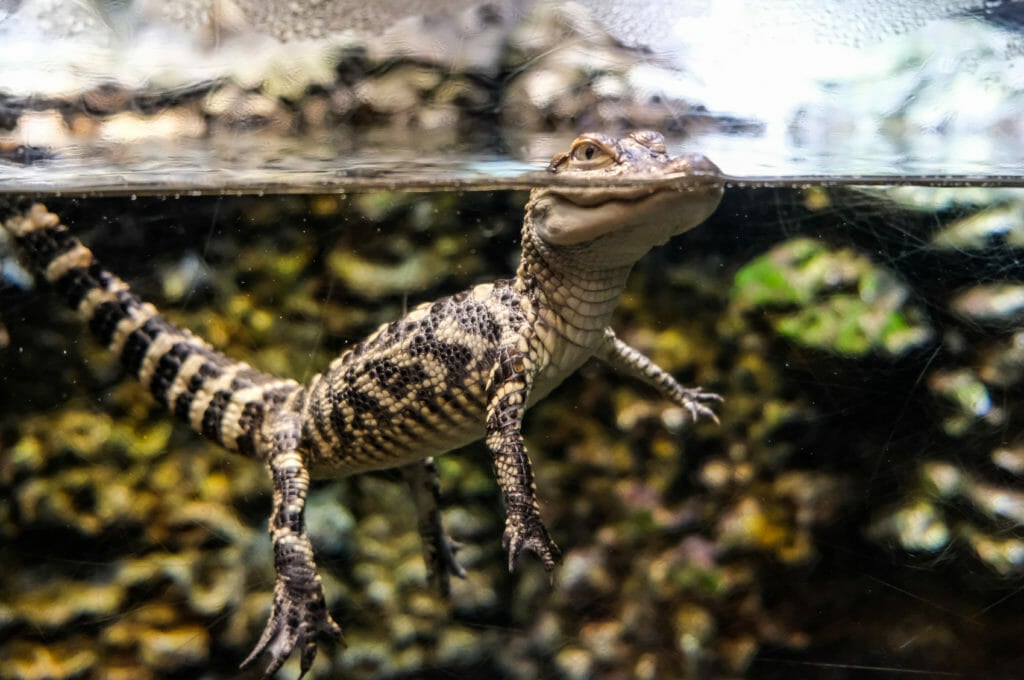
How You Can Help
Help Us Welcome the American Alligator
The largest reptiles in North America, American Alligators, are native to freshwater rivers, lakes, swamps and marshes in the southeastern U.S. — and now they also call Georgia Aquarium home.
See Them Swim, Swipe & Snap for Yourself



